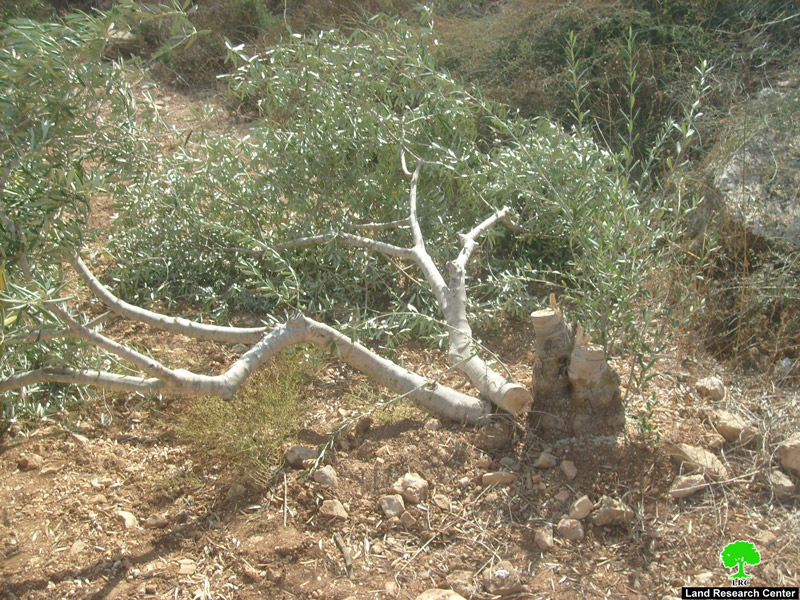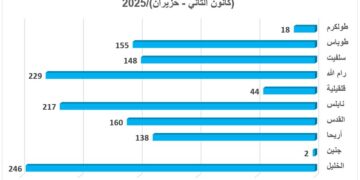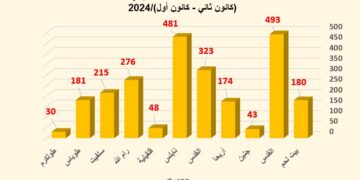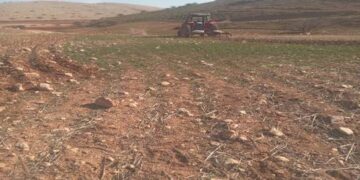Violation: uprooting and burning of tens of olive trees.
Violators: Eli’s colonists.
Victims: a number of Palestinian farmers in Al Lubban ash Sharqiya.
Date: October 21 and 23, 2010.
Preface:
The olive picking season have started; a season that Palestinians patiently wait for every year. The Palestinian farmers take good care of their fields; they check and observe the grow of the trees and the olives frequently. The farmers wait for the olives to provide them with the oil necessary for their daily food. This is what the Palestinian farmers usually wait for; Palestinians did the same year after year and generation after generation.
As soon as the olive picking season started; as soon as the colonists launched their annual war against the farmers and their fields. It has been expected from these radical colonists who hate this olive and what it symbolizes; it symbolizes peace and the Palestinian struggle. It is considered an enemy for those. It must be pointed that Al Lubban ash Sharqiya, like many other Palestinian villages, received the current season with colonists attacks.
During the last couple of days, Eli colonists burned and cut tens of olive trees. Furthermore, the same colonists raided Al Sawiyya High School, destroying and burning a great deal of furniture in addition to inscribing racist inscriptions on the school walls.
47 olive trees were cut or set alight:
Al Lubban ash Sharqiya is considered a symbol of the Palestinian suffering; the village, located in the southern part of Nablus Governorate, suffers from three large Israeli colonies placed over its ground.
Shilo, Eli, and Ma’ale Elvona occupy more than 38% of the village total area. According to the humanitarian agencies operating in the area, the village has not been spared from the colonists attacks during the last ten years.
On October 21, 2010, a group of colonists from Eli started a fire in a field located in Al Raghwat area3 km to the south east of Al Lubban. The heat and the wide spread of the weeds and bushes assisted in the widespread of the flames. The flames consumed 47 olive trees; the property of ‘Ali Nobani, Jihad Daraghma, Khader Uweis, and Jamal Daraghma.
Picture 1-4: the Lands consumed by the flames
It must be pointed that the Israeli forces appeared in the area and prevented the farmers and even the press reporters from reaching the flames; claiming that it is located nearby Eli colony. According to the president of the local village council; no one is allowed to reach the area except during certain times of the year and only after the Israeli Occupation Coordination Office approval.
The Israeli Occupation Army fire trucks came to the area after a long while, more precisely, when the flames were heading towards the colony’s fence. They acted only to protect the electricity polls supplying the colony with electricity. The farmers were allowed to reach the damaged area long after the flames erupted; there was nothing to rescue.
Cutting 14 olive trees:
The attack was not enough for the colonists fueled by hatred; at dawn, on October 23, 2010, Israeli colonists cut fourteen olive trees that belonged to Raja Uweis and his brothers. The trees were located in Al Najma parcel to the east of the village and close by Eli colony.
Picture 5-10: uprooted olive trees
Palestinian farmer was shocked to see his trees, the trees that he spend a lot of time and effort to grow, disappear like that. The owner was patiently waiting for the most important source of income for him and his twelve-member-family. It must be pointed that it is not the first time that such attacks occur. Similar attacks were previously reported. On October 22, 2007, more than 40 olive trees were destroyed south of Al Lubban; in addition to many other incidents.
Al Lubban ash Sharqiya:
The village is located 20 km to the south of Nablus city, and is located at the southern borders of the Governorate. It is surrounded by numerous Palestinian villages including Eskaka, Qaryut, Salfit, Sinjel and many others.
Picture 11: Al Lubban ash Sharqiya – an overview
The village total area is 12075 dunums including 150 dunums of built-up area, or projected built-up area.
-
240 dunums of the village area are plain fields planted with vegetables and cereals annually.
-
700 dunums are under Israeli colonies direct control were two hundred dunums were destroyed for opening road 60.
-
The rest of its lands are fields planted with prunus and olives.
The village is inhabited by 2900 people; the unemployment rate is so high reaching 51%. It is believed that the continuous Israeli closures and land confiscation is the reason for the rapid increase in unemployment. 14% of the village population work for the PA and other depend solely on agriculture as the only source of income. (Source: GIS unit – Land Research Center)

























